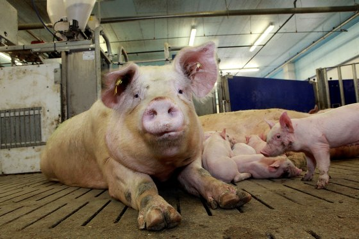Can pigs actually be optimistic or pessimistic? Or is it even possible to assess pig feelings? There has been some serious research going on into these questions. Pig welfare and health expert Dr Monique Pairis-Garcia describes how these types of trials help to push the boundaries of science.
猪到底有没有乐观或悲观的情绪?或者说我们有可能评估猪的感觉吗?关于这些问题已经有了一些严肃的研究。生猪福利和健康专家Monique Pairis-Garcia博士描述了这类型的试验如何有助于推动科学的边界。
The ‘3 schools of animal welfare’ have been one of the main foundations in assessing livestock welfare on-farm. These schools include evaluating an animal’s welfare based on it biological functioning, natural living and affective state.
“动物福利三学派”是评估农场动物福利的主要基础之一。这些学派分别通过动物的生物功能、自然生活和情感状态评估其福利状况。
1、The school of biological functioning focuses on evaluating the physical health and productivity of the animal as a means to assess welfare.
2、The natural living school focuses on the animal’s ability to perform natural, species-specific behaviours, particularly those in which they are highly motivated to perform.
3、The last school of welfare, affective states, focuses on assessing the subjective emotional experience of the animal as a means to truly understand what the animal is experiencing.
1、生物功能学派侧重于评估动物的健康和生产力,作为评估福利状况的一种手段。
2、自然生活学派关注的是动物表现自然的、物种特有行为的能力,特别是那些它们有强烈动机去表现的行为。
3、最后一个是情感状态学派,重点是评估动物的主观情感体验,作为一种手段,以真正了解动物正在经历什么。

A sow in a group housing facility during lactation in Germany. Photo: Henk Riswick
德国一个养系统中一头哺乳期母猪。图:Henk Riswick
Use of feelings to assess pig welfare
利用情感状态评估生猪福利
Historically, there has been criticism regarding the use of feelings/affective states to assess animal welfare. Some scientific camps believed that it was not our ethical obligation to assume responsibility of an animal’s affective state while others believed that subjective experiences fall outside the scope of scientific investigation.
历史上,一直有关于使用感觉/情感状态来评估动物福利的批评。一些科学阵营认为,承担动物情感状态的责任不是我们的道德义务,而另一些人则认为主观经验不在科学调查的范畴。
However, in the last 10 years, more work has been dedicated to understanding what the animal is experiencing as a means to measure welfare. This has been accomplished by using animal motivation and preference as a tool to determine what an animal wants and prefers. Studies evaluating motivation and preference have been conducted by either giving an animal a choice and observing what resource it chooses, or developing tasks in which the animal has to exert work to gain or avoid a resource.
然而,在过去的10年里,人们做了更多的研究来了解动物的感受,并以此来衡量它们的福利。这是通过使用动物的动机和偏好作为工具来确定动物想要什么和更喜欢什么来实现的。评估动机和偏好的研究是这样进行的:要么给动物一个选择,观察它选择什么资源,要么制定任务,让动物必须努力工作来获得或避免某种资源。
Cognitive bias test for pigs
生猪认知偏差测试
More recently, scientists have delved into utilising cognitive bias to better assess an animal’s physical and physiological welfare. The cognitive bias test, used by Dr Tina Horback of UC Davis, evaluates the judgement of an animal and measures how emotional/affective states of the animal can effect cognitive processes and decision-making.
最近,科学家们深入研究了利用认知偏差来更好地评估动物的身体和生理福利。加州大学戴维斯分校的Tina Horback博士使用认知偏差测试来评估动物的判断,并衡量其情绪/情感状态如何影响认知过程和决策。
This concept, defined most commonly in humans as the people viewing a situation with a glass half-full or half empty, can help shed light in understanding how the state of an animal’s welfare can influence how they may view or perceive a situation. Dr Horback conducted a cognitive bias assessment in commercial sows during her time at the University of Pennsylvania, New Bolton Center. In this study, Dr Horback evaluated the capacity for a sow to be trained to a spatial task in which they either received feed in one location or did not receive feed in another location.
这一概念在人类中最常见的定义是用半满或半空的杯子来看待同一种情况,它可以帮助我们理解动物的幸福状态如何影响它们看待或感知一种情况。Horback博士在宾夕法尼亚大学新博尔顿中心对商业母猪进行了认知偏差评估。在这项研究中,Horback博士评估了母猪接受空间任务训练的能力,在这个空间任务中,母猪在一个地方可以吃到饲料,在另一个地方则吃不到。
Sows provided with empty bowls
利用空碗测试母猪
Once training was complete, sows were provided with an empty bowl in between the 2 previously trained locations. Sows that approached the bowl anticipating feed were considered optimistic, while the sows that did not approach the bowl were viewed as pessimistic. Sows categorised as optimistic were identified to be the more dominant sows of the group, while submissive sows tended to demonstrate a more pessimistic viewpoint of the feed bowl.
训练结束后,在两个训练地点之间给母猪提供一个空碗。认为其中有饲料并走过去的母猪被认为是乐观的,而没有接近碗的母猪被认为是悲观的。被归类为乐观的母猪被视作群体中更占优势的母猪,而顺从的母猪倾向于对饲料碗表现出更悲观的情绪。
These types of studies not only help push the boundaries of science but encourage the scientific community to go beyond our traditional measures of welfare and start answering question specific to what the animal is experiencing.
这类型的研究不仅有助于推动科学的边界,而且鼓励科学界超越我们传统的福利衡量标准,并解答动物正在经历的具体问题。
Need for more welfare assessments
需要有更多福利评估
This work highlights the need for welfare assessments to expand beyond the health, productivity and behaviour of the animal and explore the psychological factors that positively and negatively influence an animal’s welfare. In addition, this work highlights the value of understanding how animal personalities can influence the success and productivity of animals in commercial settings.
这项工作强调了福利评估的必要性,以扩展到动物的健康、生产力和行为之外,并探索影响动物福利的积极和消极的心理因素。此外,这项工作强调了理解动物性格如何影响商业环境中动物生产成绩和生产力的价值。
来源:Pig Progress
作者:Dr Monique Pairis-Garcia
Assistant professor, Department of Animal Sciences, The Ohio State University, US
美国俄亥俄州立大学动物科学系助理教授
原文链接:
https://www.pigprogress.net/Sows/Articles/2019/10/Optimistic-vs-pessimistic-pigs-484761E/
(文/爱猪网记者刘坤颖编译,爱猪网原创,转载请注明出处)










